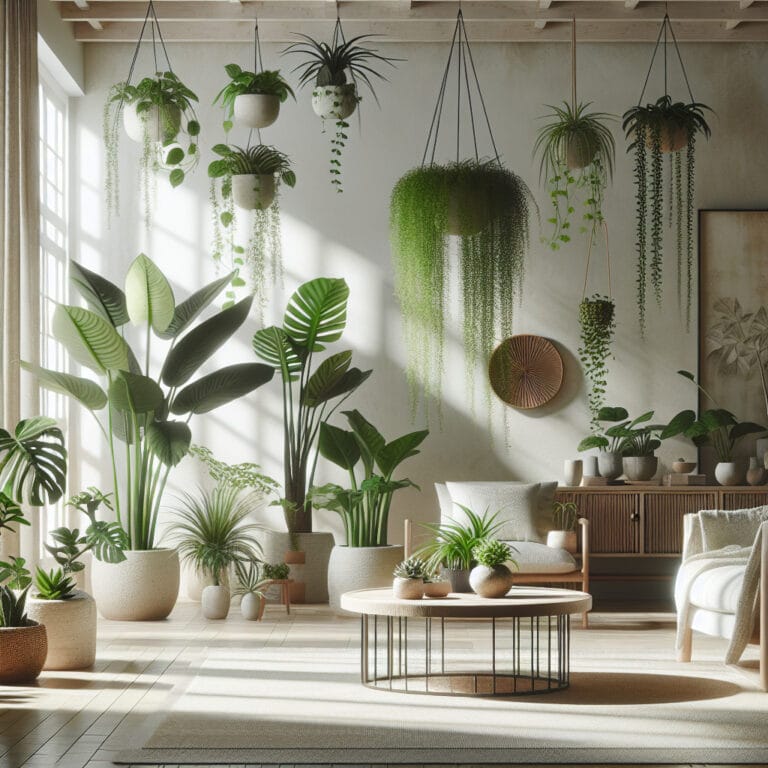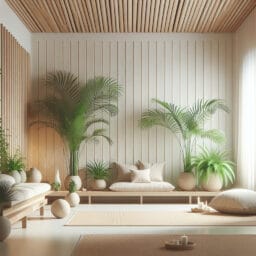
Discover the Best Plants for Creating a Calming Bedroom Atmosphere
Table of Contents
- Introduction
- The Science Behind Plants and Relaxation
- Top Plants for a Calming Bedroom Atmosphere
- Tips for Incorporating Plants into Your Bedroom
- Conclusion
- Frequently Asked Questions
Introduction
It may seem surprising, but the secret to creating a tranquil bedroom environment could be as simple as adding some greenery. Indoor plants can transform your room into a peaceful sanctuary, not just by adding aesthetic appeal but also through their calming effect and health benefits. Plants like the snake plant, also known as mother-in-law’s tongue, are popular for their air-purifying qualities. They release oxygen while diffusing toxins from the air, helping you breathe easier and promoting cleaner air in your bedroom.
In addition to being low-maintenance plants that appreciate moderate light conditions, snake plants have the added benefit of being able to grow up to several feet tall – an eye-catching addition for any room style. Similarly, peace lilies are another great choice for a calming bedroom atmosphere. This popular houseplant does not need direct sunlight and thrives in bright indirect light or even lower-light conditions.
Taking care of indoor plants like these requires checking the top inch of soil; it should remain moist without requiring frequent watering – an affordable way to add life to your space without significant effort required. The peace lily is also known for increasing humidity within its surroundings which is beneficial during dry summer months.
Another great companion for your bedroom could be small succulents such as ZZ plant or Aloe Vera with their fleshy leaves and spiky edges; they thrive in bright light but can tolerate lower light levels too. These tropical succulents have soothing ingredients commonly found in skincare products due to their healing properties.
If you prefer something more dynamic than a traditional potted plant or if space is limited consider indoor hanging plants like spider plant or English ivy that drape perfectly over hanging planter pots; these varieties tolerate low light while providing high humidity making them perfect for any bedroom window facing north or east where direct sunlight might not reach directly.
Hence keeping plants in our bedrooms allows us not only reap health benefits like cleaner air and increased moisture but also create a soothing and peaceful atmosphere conducive for relaxation. So, next time you’re seeking affordable ways to make your bedroom more restful, consider harnessing the power of indoor plants for a calming effect that lasts all night long.
The Science Behind Plants and Relaxation
Having bedroom plants offers profound benefits beyond aesthetic appeal. For instance, snake plant or mother-in-law’s tongue, stands tall at several feet and is a low-maintenance plant that thrives in moderate light conditions. It performs the miraculous task of releasing oxygen while diffusing toxins from the air to provide cleaner air. The rubber tree plant is another ideal indoor plant which appreciates humidity and releases high amounts of oxygen.
Bedroom plants also play a significant role in our psychological well-being. Greenery creates a soothing environment that can reduce stress and induce relaxation – an effect much needed after long days of work or study. Imagine reclining in bed with the sight of lush fleshy leaves from your ZZ Plant or Aloe Vera near your bedroom window – it’s a calming experience akin to being surrounded by nature’s serenity.
Adding plants like peace lilies not only adds green vibrancy to your room but also increases moisture levels, making them perfect for dry summer months. These popular houseplants do not require direct sunlight; bright indirect light suits them best making them versatile for any bedroom style.
Speaking about versatility, let’s not overlook hanging plants like spider plants and English ivy which are great additions to bedrooms with limited space — these trailing plants drape perfectly over hanging planter pots infusing lots of life into compact spaces without overwhelming them.
Take extra care though to ensure the top inch of soil remains moist without requiring frequent watering as proper care is crucial for these hardy indoor hanging plants’ survival. Interestingly, their ability to tolerate low light makes them ideal even for rooms facing north or east where there isn’t much bright sunlight coming through.
Plants such as these create an inviting atmosphere that encourages relaxation and peaceful sleep night long by improving air quality significantly —a benefit we could all use considering how many hours we spend within our bedrooms each day!
Whether you prefer small succulents resting on dressers shelves or glossy trailing vines from hanging planters, incorporating plants into your bedroom decor is an affordable way to transform it into a peaceful sanctuary. So, as you plan your indoor plant ideas check for suitable options that can thrive in your bedroom conditions – be it low-light or bright light rooms.
In essence, keeping plants in the bedroom is like having silent companions that not only enhance the room’s appeal but also contribute to our well-being by purifying air and creating a calming atmosphere. This makes them indeed a great choice for any home looking to infuse lots of life and tranquility into their living spaces.
Top Plants for a Calming Bedroom Atmosphere
With its soothing scent and unique appearance, Lavender is a great choice for a bedroom plant. This popular houseplant thrives in bright light and well-drained soil – conditions often found near any bedroom window. The small succulents with their vibrant purple flowers are not only an eye-catching addition to your space, but also produce a calming effect that promotes relaxation. Caring for these plants involves ensuring the top inch of the soil remains moist without needing frequent watering, thus making them quite low-maintenance for busy homeowners.
Snake Plant, colloquially called ‘mother-in-law’s tongue’, is another favorite amongst indoor plants due to its air-purifying qualities. Able to grow several feet tall, it’s known for releasing oxygen while diffusing toxins from the air, contributing significantly toward cleaner air in your bedroom. The Snake Plant appreciates moderate light making it perfect to be placed in any corner of the room. It’s simple care instructions include regular watering when the soil becomes dry – providing an effortless way to breathe easier each night long.
Similarly, Peace Lily stands as another wonderful option for those seeking health benefits from keeping plants in their bedrooms. This beautiful houseplant does not require direct sunlight and can thrive even under low-light conditions prevalent in many home interiors today. Besides increasing moisture within its surroundings which is perfect during summer months or heated homes; Peace Lilies are also known for removing harmful toxins from the air thus promoting overall well-being.
Next up on our list of beneficial indoor plants is Aloe Vera- a tropical succulent that goes beyond just being aesthetically pleasing with fleshy leaves and spiky edges but has also been widely recognized for its healing properties commonly found in skincare products! These hardy plants prefer bright indirect light or lower light levels too; making them adaptable companions suitable for different types of room styles.
Finally let’s explore English Ivy- notably one of best indoor hanging plant options especially if space is at a premium in your bedroom. These fast-growing trailing plants drape perfectly over hanging planters adding character without overwhelming the room decor. Not to mention, English Ivy, as a great houseplant can tolerate low light and prefers high humidity conditions making them ideal to be placed near bedroom windows where direct sunlight might not reach directly.
Proper care for all these plants involves checking the top inch of soil; keeping it moist but not waterlogged, providing bright indirect or moderate light according to each plant’s needs and ensuring they are housed in well-drained pots ensures healthy growth. By incorporating these affordable ways into your indoor plant ideas check-list you can easily transform your bedroom into peaceful sanctuary – providing cleaner air and creating a soothing atmosphere conducive for relaxation.
| Plant Name | Description | Care Instructions | Benefits |
|---|---|---|---|
| Lavender | Small succulents with vibrant purple flowers. Thrives in bright light and well-drained soil. | Ensure top inch of soil remains moist without needing frequent watering. | Its scent promotes relaxation and it’s low-maintenance. |
| Snake Plant | Known for its air-purifying qualities. Appreciates moderate light. | Water regularly when the soil becomes dry. | Releases oxygen and diffuses toxins from the air. Contributes towards cleaner air. |
| Peace Lily | Does not require direct sunlight and can thrive under low-light conditions. | Keep soil moist but not waterlogged. | Increases moisture in surroundings and removes harmful toxins from the air. |
| Aloe Vera | A tropical succulent with fleshy leaves and spiky edges. Prefers bright indirect light or lower light levels. | Ensure the plant is housed in a well-drained pot. | Has healing properties and is adaptable to different types of room styles. |
| English Ivy | One of the best indoor hanging plants. Tolerates low light and prefers high humidity conditions. | Keep soil moist but not waterlogged. Provide bright indirect or moderate light. | Adds character to room decor without overwhelming it. Can be placed in areas where direct sunlight might not reach directly. |
Tips for Incorporating Plants into Your Bedroom
Your bedroom serves as your personal sanctuary, a place of rest and relaxation. Integrating indoor plants into this setting can immensely enhance its tranquil ambiance while offering numerous health benefits. For instance, the snake plant—also known as mother-in-law’s tongue—is a popular houseplant that grows up to several feet tall, fitting well in any corner of your room. Its air-purifying qualities are second to none; by releasing oxygen and diffusing toxins from the surrounding air, it contributes towards cleaner air, assisting you to breathe easier each night long.
The lady palm is another great companion for bedrooms with high humidity levels. This low-maintenance plant appreciates moderate light conditions and thrives well near a bedroom window where bright sunlight might not directly reach but provides ample indirect light. The Boston fern also fits this description perfectly; they’re fast-growing plants providing an eye-catching addition without overwhelming your decor.
If you prefer small succulents resting on dressers or shelves instead of occupying floor space, consider incorporating ZZ plants or Aloe Vera into your indoor green space. These tropical succulents sport fleshy leaves and spiky edges which add an interesting texture amidst other soft decor elements in the room.
For those who appreciate trailing vines that drape perfectly over hanging planters infusing lots of life into compact spaces, spider plants make an ideal choice. As one of the best indoor hanging plants known to tolerate low-light conditions while still providing high humidity—properties much appreciated during dry summer months—they become perfect additions to rooms facing north or east where direct sunlight may be elusive.
Remember though that proper care for these hardy indoor companions includes ensuring they live in appropriately sized pots with well-drained soil; their top inch should remain moist but not waterlogged hence eliminating the need for frequent watering—a blissful respite for busy homeowners!
Lastly integrating soothing scents like lavender—an affordable way indeed—to complement other calming decor such as dimmable lights, soft textiles, and tranquil color schemes could amplify the calming effect of your green space. The lavender plant not only adds a pop of color with its vibrant purple flowers but also releases a soothing scent that promotes relaxation.
Thinking about bedroom plants as silent partners in our wellness journey can aid us to create our perfect peaceful sanctuary conducive for restful sleep night long. And remember, selecting suitable houseplants is just the beginning; how you place them around your room—be it by the bedroom window or near your work desk—and care for these green companions will significantly impact their ability to thrive and bring about a serene atmosphere in your space.
Conclusion
As you retire for the night, imagine resting in a tranquil oasis where peace lilies and snake plants stand tall, infusing your room with cleaner air by releasing oxygen and diffusing toxins. This popular houseplant duo not only thrives in low-light conditions near any bedroom window but also appreciates moderate light providing an affordable way to add life to your space without significant effort required. On dressers or shelves, small succulents like ZZ plants or Aloe vera plants with their fleshy leaves and spiky edges make an eye-catching addition, adding texture amongst soft textiles within your serene sanctuary.
For those facing space constraints, consider embracing the charm of indoor hanging plants like Spider plant or English ivy which drape perfectly over hanging planters; they thrive under bright indirect light while providing high humidity— ideal for dry summer months. Ensuring that the top inch of soil remains moist without frequent watering is key to their survival.
Incorporating rubber tree plant or Boston fern can increase moisture levels indoors—an added health benefit during heated homes or arid climates. Pairing these green companions with soothing scents from lavender—a great choice indeed—can amplify the calming effect contributing significantly towards a restful sleep night long. The journey towards creating a peaceful sanctuary filled with bedroom plants is not only an act of self-care but also takes us one step closer to nature right within our own homes.



